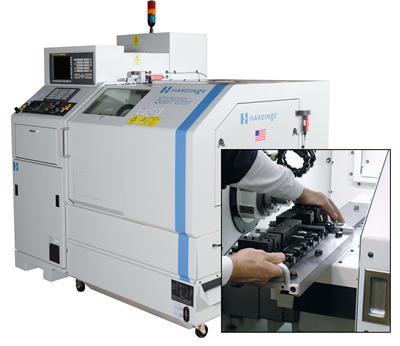
Medical part manufacturing continues to be a rapidly growing market due to the large population of aging baby boomers who are looking for "improved quality of life." Demand is high for high-precision components for neurological, orthopeadic, spinal/bone fixation, dental implants, drug infusion, catheter connectors, optical, maxillofacial, micro/minimally invasive, surgical instruments and other medical devices, most of which can be manufactured on the Hardinge QUEST SUPER-PRECISION GT27 gang-tool turning center.
The gang-tool turning center is designed for machining small diameters, complex and tight tolerance parts, and other challenging requirements. The GT27 offers a continuous machining accuracy of .0002" on diameter, part roundness variation of .000015" and part surface finish of 8 micro-inch, and has proven to be indispensible to some of the best medical manufacturing companies in the world. Bar work up to 1-1⁄16" (27mm) and chucked parts up to 4" in diameter (using a step chuck) can be machined on the GT27 today, with the ability to hold the same accuracy ten years down the road.
The Hardinge GT27 includes the company's patented interchangeable top plate and quick-change collet-ready spindle. The top plate secures to the dovetailed cross slide and is interchangeable for quick and accurate tooling changes that can be performed in under a minute. Pre-tooled top plates can be quickly interchanged within .0002" repeatability to produce a new part or family of parts. Hardinge's patented collet-ready spindle provides rigidity and gripping power because the collet seats directly in the spindle with minimum overhang from the spindle bearings. In this design the spindle accuracy is transferred directly to the workpiece. Additionally, the patented HARCRETE machine base is 10 percent stiffer than cast iron, resulting in improved dynamic stability with one-third less vibration at the spindle and a 30 percent increase in tool life, according to the company. This provides significantly better part surface finishes than cast iron. Size repeatability, surface finish quality and thermal stability are hallmarks for Hardinge lathes.
The Hardinge GT27 can be used as a stand-alone unit, a higher capacity system with a bar feed, or as a fully automated system with a robot. This machine is an excellent complement to a Swiss machine shop to handle parts that require higher precision. Bar whip or chatter that may be found to some degree in Swiss turning, is not an issue with the GT27 because the bar or chucked part is gripped close to the spindle bearings.
Contact Details
Related Glossary Terms
- chatter
chatter
Condition of vibration involving the machine, workpiece and cutting tool. Once this condition arises, it is often self-sustaining until the problem is corrected. Chatter can be identified when lines or grooves appear at regular intervals in the workpiece. These lines or grooves are caused by the teeth of the cutter as they vibrate in and out of the workpiece and their spacing depends on the frequency of vibration.
- collet
collet
Flexible-sided device that secures a tool or workpiece. Similar in function to a chuck, but can accommodate only a narrow size range. Typically provides greater gripping force and precision than a chuck. See chuck.
- family of parts
family of parts
Parts grouped by shape and size for efficient manufacturing.
- feed
feed
Rate of change of position of the tool as a whole, relative to the workpiece while cutting.
- tolerance
tolerance
Minimum and maximum amount a workpiece dimension is allowed to vary from a set standard and still be acceptable.
- turning
turning
Workpiece is held in a chuck, mounted on a face plate or secured between centers and rotated while a cutting tool, normally a single-point tool, is fed into it along its periphery or across its end or face. Takes the form of straight turning (cutting along the periphery of the workpiece); taper turning (creating a taper); step turning (turning different-size diameters on the same work); chamfering (beveling an edge or shoulder); facing (cutting on an end); turning threads (usually external but can be internal); roughing (high-volume metal removal); and finishing (final light cuts). Performed on lathes, turning centers, chucking machines, automatic screw machines and similar machines.

